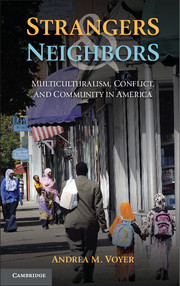Book contents
- Frontmatter
- Contents
- List of Figures and Tables
- Acknowledgments
- Introduction Strangers in a Strange Land
- 1 Ellis Island South and Maine’s Mogadishu
- 2 The Meaning of Somali Settlement and the Boundaries of Belonging
- 3 Being the Inclusive Community
- 4 Disciplined to Diversity
- 5 Familiar Strangers
- Conclusion Cultural Scaffolding
- References
- Index
4 - Disciplined to Diversity
Published online by Cambridge University Press: 05 June 2014
- Frontmatter
- Contents
- List of Figures and Tables
- Acknowledgments
- Introduction Strangers in a Strange Land
- 1 Ellis Island South and Maine’s Mogadishu
- 2 The Meaning of Somali Settlement and the Boundaries of Belonging
- 3 Being the Inclusive Community
- 4 Disciplined to Diversity
- 5 Familiar Strangers
- Conclusion Cultural Scaffolding
- References
- Index
Summary
When I attended my first diversity training, the “Two Towns of Jasper Project,” I observed uncomfortable group dynamics resulting from the perspective that emerged in the group discussions – the view that the struggles of Somali incorporation in Lewiston resulted from the “fences” in people’s hearts and minds. Participating in the frequent diversity training sessions offered in Lewiston, I noted a similar perspective emerging in a host of curricula developed by the various local, regional, national, and international organizations offering diversity training in the city. I began calling the psychological and anti-racist orientation characteristic of the method “confronting your inner racist” because of the emphasis placed upon participants coming, through the training process, to a greater understanding of their individual biases, the origins of these biases, and the impact they have on participants’ lives and communities.
The focus on racially biased, bigoted, or otherwise immoral people and the adoption of abstract guidelines and programs as the panacea for the difficulties of immigrant incorporation and multicultural community building in Lewiston left me puzzled. My sociological predisposition to believe that culture and structure were important elements of both racism and multicultural incorporation was not reflected in the psychological orientation of the narratives and institutional strategies characterizing the response to Somali settlement. Likewise, programs and policies in Lewiston did not generally reflect my assumptions regarding the strain that cross-cultural contact can place on intergroup relations. Where I perceived the need for deep and specific information about different cultures and careful anticipation of and strategizing around likely cross-cultural conflicts, I witnessed the adoption of culture-blind standards and the development of educational opportunities that focused on the psychology of individuals instead of structural limitations.
- Type
- Chapter
- Information
- Strangers and NeighborsMulticulturalism, Conflict, and Community in America, pp. 109 - 146Publisher: Cambridge University PressPrint publication year: 2013



